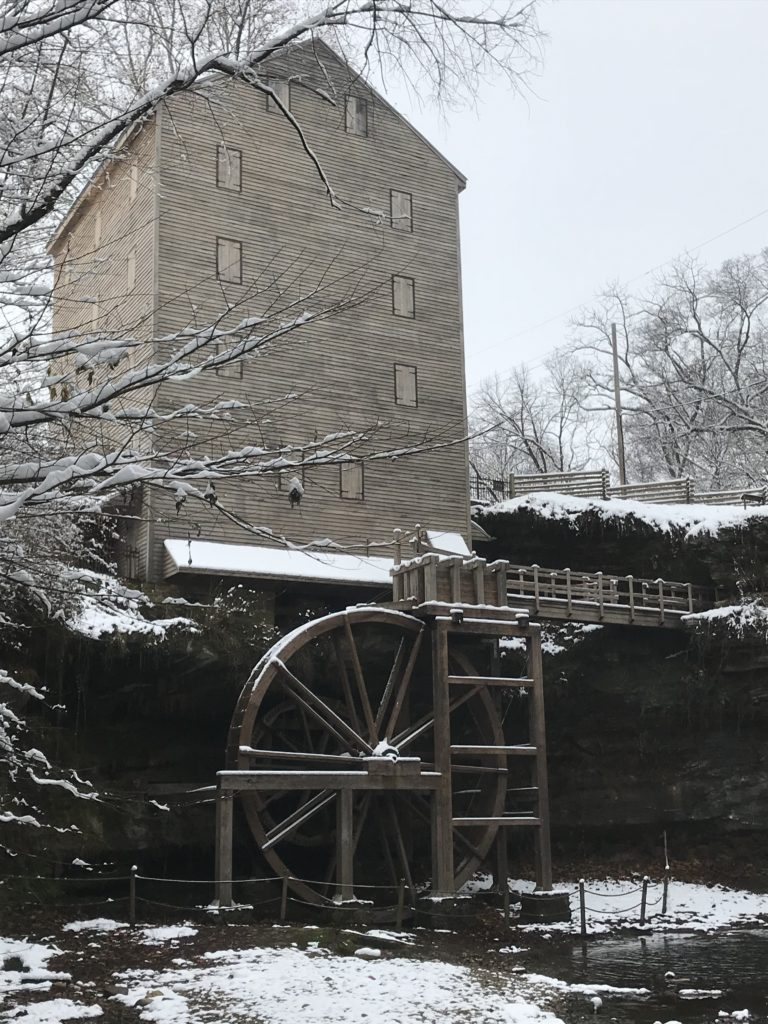Rock Mill
Location: Stebelton Park at Rock Mill
1429 Rockmill Pl NW; Lancaster | MAP
Hours: Open Year-Round, Dawn to Dusk
Description: Built in 1824, Rock Mill was one of a dozen mills in the area whose power source was the Hocking River. It was in operation as late as 1901. For nearly 100 years, it sat vacant and in disrepair. After 2003, a labor-intensive restoration was begun. A replica of the 26′-diameter all-wood waterwheel was crafted and installed; it is the largest of its kind in the state. In 2017, Rock Mill roared to life! People from all over the U.S. and beyond visited to see the mill in action. Each year, on Saturdays and Sundays from May through October, the mill is open for visitors to tour inside and experience a bit of history.

Its History
Rock Mill #1 (1799-1820)
It was 1799 when Joseph Loveland and Hezikiah Smith built the first Rock Mill. Not long after, they built a general store and a tannery. As business increased, they built a distillery and Blue Ball Tavern. The first Rock Mill stood for 21 years, until 1820, when it literally fell into the gorge.
Rock Mill #2 (1820-1822)
In 1820, James Brook erected a new mill. The date is not verified. B. M. Brook, the grandson of James, recollected that he was 5-years old when the mill was being built by his grandfather. He remembered it because during construction his father fell into the deep pool of water at the bottom of the ravine making it a memorable experience. That second mill was destroyed by flooding just two years later, 1822.
Rock Mill #3 (1824-Present)
1824-1905
The property changed hands again. Christian Morehart built this Rock Mill in 1824. This mill he built just a bit higher up the rock face and more out of the way of flood-water levels. All the timber framing is oak. It is five and a half stories high. It rests on two sandstone ledges in such a way that the power and grinding levels of the structure are partially subterranean. Three and a half stories stand above the rim of the deep gorge.
A 26-foot overshot waterwheel powered the mill. The waterwheel was powered by the waters of Hocking River which were dammed above the 14′ natural waterfall and channeled to the mill area. A millrace was chiseled through solid rock just above the falls in front of the mill. The millrace was 30′ long, 18′ deep, 3′ wide. Water from it was transported to the wheel by a wood flume.
It served as a flour and grist mill, one of a dozen mills in the area whose power source was the Hocking River. It is said that Morehart intended his new mill to be used for wool as well but the wool machinery was never installed. Morehart died June 4, 1859.
The mill passed into the hands of Phillip Homrighouse, then to John Fore. A company names Solt, Alspaugh Bros & Fore then operated the mill for a period of time after which Ed Alspaugh bought out the other partners. An 1899 remodeling resulted in the installation of a water turbine. However, it did not work well and, in 1901, the power source was changed to steam.
Rock Mill stayed in operation as late as 1905.
1905-2003
There were other owners but not all are listed here. Some sources mention Abraham Bookwalter and Joseph Knabenshue as owners. In 1928, W W Alspaugh, the grandson of Christian Morehart, was an owner. At some point Urcel Alspach* became owner of the mill and surrounding property. In 1994, Stebelton bought the property from Alspach; he owned it until 2003. He began restoring the mill, pouring concrete footers and installing a massive steel beam to prevent this mill from the same fate at the first two – falling in to the gorge. Read more about the Stebelton family in the article, “Stebelton Park at Rock Mill Named After Benefactor”.
*It seems that the Alspaugh surname has been used interchangeably with Alspuch and Alspach. Perhaps some members of the family dropped the German spelling.
2003-Present
For nearly 100 years, the building sat vacant and in disrepair. Although Bob Stebelton did much to save the mill, “the undertaking got to be a little too much [for one man],” Rita Stebelton said during an interview in November 2017. Rather than allow it to decay beyond repair and lose the mill forever, they decided to donate it to Fairfield County Parks.
After 2003, a labor-intensive restoration was begun. There was an excavation that revealed original mill stones and many artifacts from bygone days.
New siding, wood windows, shutters, beams and posts were replicated to replace rotted and missing pieces. Stonework was done below ground to the foundation, a master carpenter was used to recreate stairs and the milling floor, massive new wood gears were constructed. A millwright was engaged to craft a replica of the 26′-diameter all-wood waterwheel. It was installed in September 2012; it is the largest of its kind in the state.
Finally, in 2017, Rock Mill roared to life! People from all over the U.S. and beyond visited to see the mill in action.
Rock Mill Weekends
Each year, May through October, on Saturdays and Sundays from 12:00-4:00 p.m., Rock Mill is open for tours and, on the last Sunday of each month, there are grinding demonstrations. This event is run by Fairfield County Forever (the friends group) and Fairfield County Parks’ volunteers. Please come to see this fabulous structure and Rock Mill Covered Bridge. For details, see Calendar of Events.

Social Contact